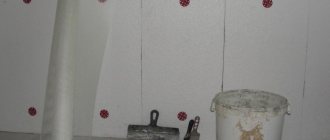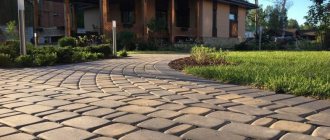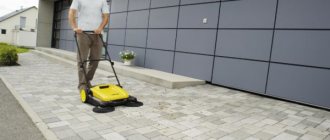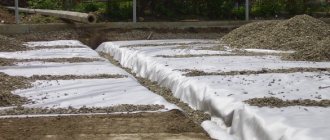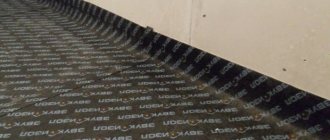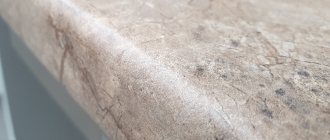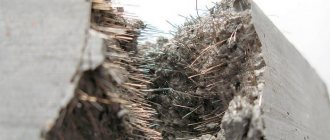Geotextile is a non-woven material that consists of polymer fibers (polypropylene, polyamide). This material is produced in several types. In this article we will consider the main advantages and disadvantages of geotextiles and their areas of application.
Types of woven geotextile fabric:
- Knitted geotextile is the cheapest in cost, it is easily destroyed under mechanical loads, the fabric simply unravels when damaged. It is not recommended to use this material in construction.
- Woven geotextile - fibers are connected by weaving, this is a more durable material. Widely used in landscape construction for drainage.
- Thermally bonded geotextiles - the fibers in this material are subjected to thermal and chemical treatment. This material already has sufficient strength for the construction of drainage systems.
- Needle-punched geotextiles are the most versatile, but also expensive material when compared with the above. It filters liquids well, has high strength, and can be used on any soil.
Characteristics of geotextiles:
- The material is not flammable;
- Environmentally friendly;
- It filters water well and retains particles of silt and sand, so there is no mixing of different layers in building structures;
- Works well in various temperature conditions (-60 - +90 degrees);
- Service life is about 25 years;
- Does not rot and is not damaged by rodents.
Composition and types of geotextiles
Geotextiles are similar to ordinary fabric, but they can have different structures. This material consists of the finest synthetic threads, which are pressed together and are of a polyester or polypropylene nature.
Depending on the dominant ingredient in the composition, geotextiles come in the following types:
- Polyester. The material consists of thin fibers. Polyester geotextiles are environmentally friendly, but they have low resistance to acids and alkalis.
- Polypropylene. Durable and reliable material that does not rot or mold. This type of geotextile has an excellent filtration coefficient.
- Combined. This type is made from various recyclable materials. It has a low cost, but is inferior to polypropylene and polyester material in strength and durability. Combined geotextiles include natural additives that quickly rot. In their place, voids form, increasing the likelihood of damage to the product.
Agrotextiles and its varieties
Those who have been gardening for a relatively long period have probably heard, and perhaps experienced from their own experience, what agrotextiles for the garden are. Despite its artificial origin, this material is not at all similar in properties to film. It has appeared quite a long time ago and opinions about its use among gardeners and gardeners are sometimes striking in their inconsistency. But the thing is that many, even experienced gardeners, do not always see the difference between its main varieties and often call the same thing by different names. Or, conversely, completely different materials in their properties and purpose are called by the same name. We need to clear up some of this confusion.
Agrotextiles, and sometimes called geotextiles, are a common name for two types of covering material for beds made from polypropylene: non-woven material (agrofibre) and, in fact, fabric (agrofabric).
Historically, agrofibre was the first to appear, the technology for its production is called spunbond - in recent years this name has become almost a household name for all materials with covering properties. The texture of agrofibre resembles a material with many small round holes.
Agrofibre comes in different densities and colors: from the thinnest (17 g/sq. m) to the densest (60 g/sq. m). The colors are white, black, and in recent years multi-colored ones have appeared: black and white, red and yellow and others. Only dense black agrofibre is suitable as mulch.
To do this, it needs to be laid with white on top.
Agrofabric is a woven material of high density (from 90 to 130 g/sq. m). Due to its woven base, its texture is an interweaving of threads that form cells. It is most often black, but green and brown are also found.
Agrofabric has incomparably high strength characteristics that are incomparable even with the most durable agrofibre models. Therefore, they have slightly different areas of application. And it’s difficult to compare them in price; of course, agrofabric will be several times more expensive than agrofibre. But as a covering material against weeds, both agrofabric and agrofibre do a good job of their duties, although there are some nuances here too.
Agrofibre and its use against weeds
The fact is that the technology of manufacturing spunbond or nonwoven material itself is used not only in agriculture. This material is also widely used in light industry, in the manufacture of hygiene products, in the construction industry and furniture production. But these materials differ from agrofibre primarily in that they do not contain an ultraviolet stabilizer, which means they are not intended for use when exposed to solar radiation. This does not affect the appearance of the material in any way, but its price can be much cheaper.
After all, such material of the appropriate density (60 g/sq. m) should last you at least three years. And if it began to fall apart by the end of the first season, then you obviously bought something wrong.
Agrofibre is most often used to cover the surface of the soil when growing strawberries.
In the case of updating a strawberry plantation, the material is thrown away along with the old strawberry bushes that have served their purpose. Agrofibre can protect strawberries well from weeds, provided that no one walks on it. Otherwise, its mechanical strength may not be enough. But for creating paths between the beds, the best option would be to use agrofabric.
Which geotextile to choose?
needle-punched geotextile
dornite
Heat set
Heat treated
Knitted, with stitching
construction
The choice of material depends on its purpose. The most popular options:
- Needle-punched. This tissue is produced by bonding microscopic fibers together. Moisture passes through its structure, so the material will not be flooded by precipitation.
- Doronite. This geotextile is suitable for constructing a reinforcing substrate and has excellent filtration properties.
- Heat set. The fibers of this geotextile are carefully melted together through heat treatment. This production technology gives the material high strength. However, the heat-fixed variety has low filtration properties, because its structure allows moisture to pass through only in the transverse direction.
- Heat treated. The ingredients are fused and pressed together at the same time. As a result of this processing, an extremely dense and reliable material is obtained. Most often, this geotextile is used for waterproofing.
- Knitted, with stitching. The fibers of this material are tied together with strong threads. Knitted geotextiles effectively pass liquid through their structure, but have low resistance to mechanical loads.
- Building. This material allows liquid to pass through only from the inside, so it can be used for waterproofing.
It is necessary to select material for arranging garden paths taking into account the following criteria:
- Density. The throughput of the geotextile fabric depends on this factor. The density of the drainage material should be in the range from 150 to 300 g/m³. The pore size should be 175 microns. If the density of the geotextile is lower, it will be less durable.
- Filtration coefficient. This indicator indicates the water permeability of the material. The optimal value for drainage material is from 100 to 300 m/day. The exact indicator is selected depending on the groundwater level, the volume of climatic precipitation and the degree of soil permeability. If the garden area is regularly moistened, it is recommended to take a canvas with the highest filtration coefficient.
- To arrange a garden or summer cottage, you can choose any type of geotextile. However, experts recommend giving preference to polypropylene material, which is made of smooth and durable monofilament. This fabric is characterized by increased resistance to silting. In addition, you can use the heat-bonded type, because needlepunch quickly silts up and does not allow moisture to pass through well.
- It is not advisable to lay woven material under garden paths, because... its fibers quickly rot in the soil.
- The tensile strength level of garden geotextile fabric must be at least 1.9-3 kN/m. The resistance of the product to punching must be selected based on what material will be used for drainage, as well as how deep the drainage system will lie and how intensely the soil will move. In most cases, an indicator of 400-500 N is sufficient. When using large crushed stone, this geotextile indicator should be higher. All necessary information can be found on the product packaging.
- Financial savings. This factor is of great importance. When choosing a canvas, you need to choose the right ratio of quality and cost. Most often, the price of geotextiles ranges from 10-20 rubles. for 1 m². The cost of imported high quality material can reach 200-300 rubles. for 1 m². At the same time, Russian products are not inferior in quality and reliability to many imported analogues
Use of geotextiles in construction
This material is widely used in the construction of foundations; it performs filtering functions that prevent siltation of the structure and extend the overall service life of concrete. When constructing a foundation, it is necessary to install a geotextile fabric slightly larger than the foundation area. After installing the main structure, the material is lifted onto the walls.
When constructing buildings with high groundwater levels, a deep drainage device is used. In this case, geotextiles are actively used. A cushion of 150-200 mm of crushed stone is made in the drainage trenches, then a roll of geotextile is spread. A crushed stone cushion is made again, drainage pipes are installed and a sheet of material covers them. In this case, the drainage will last much longer, since the geotextile will allow water to pass through and retain all small impurities.
Currently, this rolled material is widely used in road construction and for the construction of pedestrian paths. The base for these types of work is compacted and a crushed stone cushion is made. Then geotextiles are installed, a sand cushion is laid over the material, paving stones are installed, and monolithic concrete paths are laid. The entire complex of these works extends the service life of roads and pedestrian paths.
Advantages and disadvantages of geotextiles
This material has the following advantages:
- compact dimensions;
- small weight;
- high level of strength;
- affordable price;
- the ability to “breathe” (for Dornit geotextiles);
- easy and quick installation;
- easy transportation;
- the ability to maintain normal heat exchange in the soil;
- high resistance to chemical and mechanical influences;
- ability to inhibit weed germination, etc.
Disadvantages of geotextiles:
- low resistance to direct exposure to ultraviolet radiation;
- high cost of some types of material.
Weed control film
Until recently, black weed film was the main material used by gardeners. Since it has excellent darkening properties, weeds actually do not survive under it. The disadvantage of this material is that since it does not allow water to pass through, the condensation that accumulates under it causes the development of fungal diseases. In addition, it is usually enough for one season.
Geotextiles for garden paths
A beautiful garden plot requires properly and efficiently arranged paths. They can be constructed from different materials. Sometimes the marked strip is sprinkled with pebbles or crushed stone, after which the surface is carefully leveled.
You can arrange garden paths using granite or basalt paving stones. When constructing them, it is imperative to ensure that there is a good drainage system for water.
When arranging paths made of pebbles or gravel, it is enough to lay 1 layer of geotextile fabric. If additional paving is carried out with tiles, it is necessary to lay out an additional underlay. In this case, it is better to use 2 layers of geotextile.
Crushed stone paths on sandy and clayey soils must be constructed carefully, because the coating can quickly shift, bend or sink into the soil.
It is forbidden to lay tiles on dry mixtures, because with the arrival of cold weather, its surface will crack, and the monolithic concrete base will prevent water from draining.
Black agrofibre or two-tone material?
Amateur gardeners, as well as farmers who grow fruits and vegetables on a large scale, are freed from the need to purchase and use herbicides against weeds. They also don’t have to spend time at their summer cottages with hoes, spending a lot of physical effort and time on weeding. There are simply no weeds. Only useful crops grow in even rows.
In addition, the fruits remain clean after rains, since they do not come into contact with the ground. Strawberries grown on beds covered with agrofibre can be harvested immediately after rain. The berries lie on a dry cloth and have an excellent presentation. They can be served on the table, lightly rinsed from dust, or taken to the market for sale. Using black mulching agrofibre, you can achieve earlier ripening of the crop. It is possible to reduce the growing time of crops to two weeks by early warming up the soil under cover.
The use of mulching agrofibre eliminates a large amount of work on caring for plantings in the garden, since there is no need to weed the beds
An interesting new product has appeared in the range of covering materials - two-color mulching agrofibre, which is superior in functionality to conventional black canvases. The manufacturer has improved the product by combining two thin layers of white and black. As a result, the covering material is black on one side and white on the other. The dark side of the canvas is laid on the ground, and the light surface is on top and reflects sunlight that falls on plants and fruits from below, accelerating their growth and ripening.
Important! The white surface of the mulching two-color agrofibre prevents the root system from overheating, which affects the growth rate of crops grown on the site and the uniformity of fruit ripening.
Step-by-step instructions for installing garden paths
To achieve a good result, you need to first prepare the following materials and tools:
- required number of geotextile fabrics;
- tiles or paving stones;
- sand;
- crushed stone;
- shovel;
- rubberized hammer.
To begin with, the outline of the garden path is placed. For this purpose, you can use bricks, tiles, etc. To achieve maximum evenness, it is better to mark the contours with long cord and stakes.
Arrangement of slab-crushed stone path using geotextiles
The construction of a crushed stone path with a geotextile backing is carried out sequentially and according to the following scheme:
- First, paving stones or tile products are laid out on unprepared soil. This is necessary to calculate the amount of material and determine the boundaries of the structure.
- A trench is dug along the intended width. Its depth can be from 30 to 40 cm.
- The bottom of the recess is leveled. Everything unnecessary is removed from it, including plant roots and debris.
- After this, geotextiles are laid on the bottom surface. In this case, its edges should protrude 4-6 cm above the ground.
- Then crushed stone is poured. This layer should be about 14-15 cm thick.
- After this, it is necessary to lay the next geotextile layer.
- Fine sand is poured on top of the laid material. This layer should be 11-12 cm thick.
- The formed substrate must be compacted. After this, you can lay tiles or paving stones.
- After completing the laying of the paving material, you need to trim off the protruding parts of the geotextile fabric.
- Fine-grained sand should be poured into the cracks between tiles or paving stones. Additionally, the coating must be compacted by tapping its surface with a rubberized hammer. The path must be compacted until all the cracks between the tiles are filled with sand.
- At the final stage, you only need to decorate the edges of the path. To do this, you can sprinkle them with fertile soil with seeds of garden plants.
Features of a track with a geotextile backing
A garden path equipped with geotextile fabrics will retain its configuration for a long time.
In this case, the crushed stone layer will be used as drainage, through which moisture will freely drain into the sand and soil. As a result, the layer is compacted, and the geotextile fabric ensures the unhindered removal of excess moisture.
Sand poured onto geotextiles acts as a cushion for decorative material laid out on the surface. If any tile product begins to sag, the path can be quickly and easily repaired. To do this, you just need to lift the settled element and sprinkle a little moistened sand under it, then compact it with a mallet.
Other tasks of geotextile material in landscape design
Geotextile fabrics can improve the area and make many jobs easier. In addition, this material allows you to realize original ideas.
Geotextiles are used for fixing coatings and zoning, as well as constructing drainage and effectively cleaning the soil. If you lay this material under a turf layer, you can:
- slow down soil erosion;
- strengthen the hills;
- prevent the natural removal of beneficial compounds from the soil;
- prevent the growth of weeds whose roots cannot penetrate the dense layer of geotextile;
- ensure effective water drainage, etc.
Solving the problem of grass growth on crushed stone and gravel paths
In practice, eliminating the growth of weeds in a dacha or garden is an impossible idea. Fallen leaves and soil found on gravel and crushed stone paths, one way or another, become the basis for grass germination. However, proper care will ensure a neat appearance for your garden space. It is enough to remove the foliage in time with a fan rake or a garden vacuum cleaner. And treat germinating grass, for example, with Roundup and Tornado, without waiting for it to gain growth.
Material for crushed stone
A little about geogrid
Many gardeners use geogrids to landscape their plots. This structure is made of the same materials and using similar technology as geotextile fabric.
Geogrid can be used to prevent soil movement and damage. In addition, it prevents soil from being washed away. This material is not afraid of aggressive chemical influences, does not contain toxic substances in its composition and is highly resistant to exposure to sunlight.
Types of non-woven covering materials
Nonwoven materials are produced not only to control weeds, but also to protect plants from return frosts and excessively scorching rays of the sun. Therefore, when choosing a material, you must pay attention to the manufacturer’s recommendations. Weed control material is sold on the market under different names, such as:
- "Agril";
- "Spunbond";
- "Lutrasil";
- "Agril";
- "Agrotex";
- "Lumitex";
- "Agrospan" and others.
Regardless of the name, manufacturers divide all non-woven covering materials into four groups:
Each group is endowed with a certain set of properties and characteristics that influence the way this covering fabric is used. For example, light, low-density canvases are used to cover beds to protect seedlings from frost. Growing seedlings lift weightless material with their tops, while remaining under reliable shelter from unfavorable climate conditions. Non-woven fabrics from the fourth group, which have the highest density and are black in color, help in the fight against weeds. Thanks to its dark color, the material retains sunlight, while perfectly accumulating heat. The listed properties determine the main purpose of using non-woven material, which is to mulch beds.
Non-woven covering materials have unique qualities that allow them to inhibit the growth of weeds and ensure free penetration of moisture and air to the root system of plants

